
When I had my garden I used to grow Nasturtiums along the edge. They grew quickly filling in the alloted spot and spilled over the border edge. They were stunning. Even when the garden looked leggy or sparse it just seemed more bountiful and pretty with that edging. I originally only grew them for looks and because I had heard they help keep bugs away from the garden. Then I tasted them. The leaves are awesome lil peppery bites in a salad or whatever your making. I would bring armfuls of the flowers to work to garnish plates there. I had to spread it around they were just too pretty to keep to myself. Now of course in order to do all this , they must be kept pesticide free but they really don't need any anyway. I miss that and while wandering online I saw some interesting recipes to use these in. Hope you enjoy them.
~~~~~~~~~~~~~~~~~~~~~~~~~~~~~~~~~~~~~~~~~
Nasturtiums grow quickly from seed and one packet is plenty. I've found most packets have about 25 seeds. Space your seeds 8-12 inches apart in the ground, and a little closer in containers. In zones with freezing temperatures wait until after the frost, and in the mild southern climates they can even be planted in the fall for "winter" blooming. I've found the trick with nasturtiums is to keep them watered during the entire growing season. Especially when they are in containers. They love full sun, but they don't do well in drought-like conditions. As long as you keep them watered and give them room for the air to circulate they are a prolific flower. The soil shouldn't be too rich because you will get more leaves than flowers. The soil can even be slightly sandy and they will thrive. You can use barrel planters, window boxes or porch boxes too. Pick the blooms freely once they start coming, and you will have many more during the summer. I water mine once in awhile with the water from our fish tank, to give them a little boost. If you do notice aphids you can spray them with a safe soap, alcohol and water mixture. Remember, as with herbs, you don't want to use chemicals on your plants.
It's important to keep your nasturtiums free from any exposure to chemicals. They do trail and spread, and so be aware of this if anything nearby is treated. I think of them as a flowering spicy green, and grow them as such. The leaves and blooms can be added to any salad, used as garnish, or chopped into pasta salads.
The seeds were ground during World War II as a replacement for pepper and you can still do this. Wait for the seeds to dry-they are larger than peppercorns-and grind them in a grinder. You can add this mixture with herbs to make a savory herb salt as well. Store in tightly closed bottles.
The fresh seeds can be pickled as a type of substitution for capers, which are fairly expensive. After the blossoms wilt and form seed pods, pick the greenish pods off the plant for this recipe.
Nasturtium Capers
1 quart white wine vinegar
2 teaspoons pickling salt
1 thinly sliced onion
1/2 teaspoon each allspice, mace and celery seed
3 peppercorns
nasturtium seed pods
Keep the solution refrigerated in a sealed bottle and drop the seed pods into it as they are ready. Keep them refrigerated and later use in place of capers.
Nasturtiums Filled with Guacamole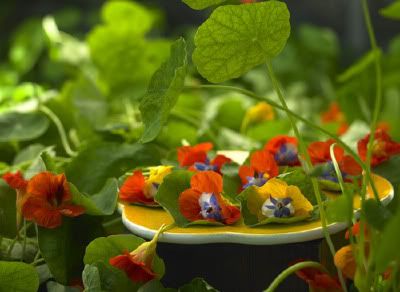
Piquant nasturtium blossoms are a wonderful foil for guacamole, and the jicama provides a nice, crunchy base. If you don’t have jicama, Jerusalem artichokes or cucumber slices are a good substitute. This recipe is excerpted from the book Flowers in the Kitchen (Interweave Press, 1991).
1 large avocado, preferably Hass
2 teaspoons lime juice
1 small tomato, finely chopped
2 tablespoons finely minced onion
1 jalapeño or serrano chile, seeded and finely minced
1 small clove garlic, finely minced
Salt, to taste
About 20 nasturtium blossoms
1 small jicama
Lime juice
Peel avocado and remove pit. Mash avocado in a bowl with a fork and add lime juice. Blend in tomato, onion, chile and garlic. Add salt to taste. Let guacamole stand, covered, while preparing the nasturtiums and jicama.
Rinse nasturtiums carefully and pat them dry. Peel jicama and slice it about 1/4-inch thick. Cut the slices into pieces about 2-by-2 inches in size. (They don’t have to be perfect squares—leave the rounded edges.) They should be just the right size to accommodate a nasturtium filled with guacamole. Squeeze a little lime juice over the jicama slices.
At this point, the guacamole, jicama and nasturtiums can be kept for a few hours in the refrigerator, if necessary. To assemble the appetizers, hold nasturtiums at the base and use a teaspoon to fill them carefully with the guacamole. Set each filled nasturtium on a slice of jicama and arrange on a serving platter. The prepared appetizers can be kept very briefly in the refrigerator or served immediately.Serves 20
Stuffed Nasturtiums
3 ounces softened cream cheese
1 tablespoon heavy cream
2 tablespoons minced fresh chives
Salt to taste
30 large nasturtium blossoms
Mix together the cream cheese, heavy cream, chives, and salt until smooth. Spoon about a teaspoonful of the mixture into the center of each flower. Fold the petals up around the stuffing. Chill for up to an hour before serving. Makes 30 appetizers.
Nasturtium Mayonnaise
T his recipe is the perfect compliment to chilled summer salmon, or any fish, fresh off the grill. Also makes a great spread for tea sandwiches, or any sandwich needing some zip.
1 cup mayonnaise
1/4 tsp. finely minced garlic
2 tsp. coarsely chopped capers
1/3 tsp. grated lemon peel
2 tsp. chopped nasturtium leaves
Combine all ingredients. Keep chilled until ready to use. Makes 8 servings as a sauce for fish .
Nasturtium Vinegar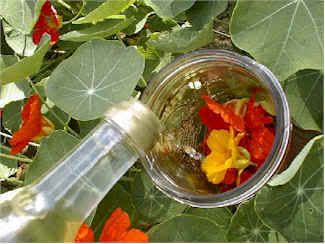
The finished vinegar has a nice peppery bite and makes an excellent ingredient to use in salad dressings, sauces, and other dishes.
1 cup nasturtium leaves, flowers, and buds
1 pint champagne, white wine, or apple cider vinegar
Place the ingredients in a clean clear glass jar or bottle. Tightly seal. Let sit for at least 3 weeks before using. The nasturtium can remain in for decoration, but you should make sure the vinegar always covers the flowers or they will mold. Makes 1 pint vinegar.
Strawberry-Nasturtium Salad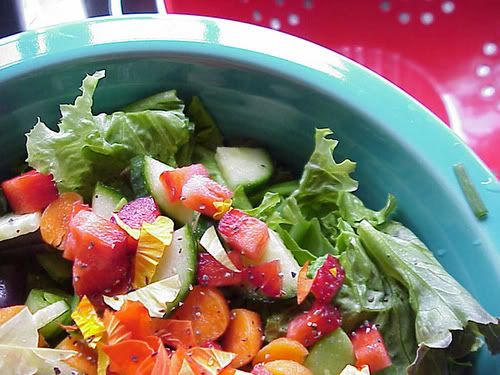
This unique salad is filled with delightful flavor and color. The sweetness of the strawberries is perfectly balanced by the pepperiness of the nasturtiums and spark of the vinegar for a salad that everyone will love. This salad should not be made too far in advance to prevent wilting of the nasturtium blossoms.
1 pint sliced strawberries
1/3 cup nasturtium blossoms
2 tablespoons champagne vinegar
2-3 tablespoons sugar
Toss together all of the ingredients. Taste the mixture, and adjust the amount of sugar depending on how sweet the strawberries are. Makes 4 servings.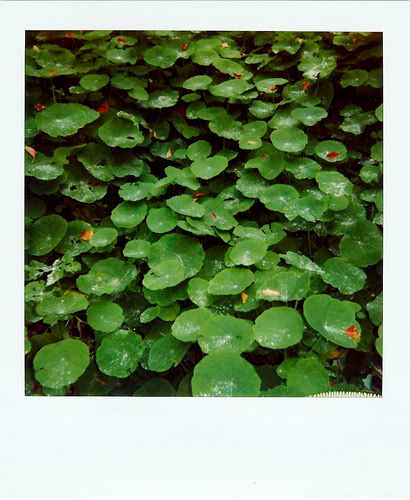
Salmon-Cucumber Stuffed Nasturtium Leaves
Nasturtium leaves are very similar to watercress leaves, and have the same affinity for cucumber and salmon that watercress does. These little rolls are very easy to make and offer a beautiful presentation. Homemade salmon cream cheese can be made by mixing equal amounts of lox and softened cream cheese.
2 ounces softened salmon cream cheese
1/4 cup finely minced cucumber
Salt to taste 20 large nasturtium leaves
20 long stemmed nasturtium blossoms
Mix together the salmon cream cheese, cucumber, and salt until smooth. Spoon about a teaspoonful of the mixture into the center of each leaf. Roll the leaves up into a tight roll. Wrap the blossom stems around the leaf and tie tightly. Chill for up to an hour before serving.
Nasturtium and Potato Soup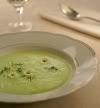
2 tablespoons butter or margarine
1/2 large sweet onion, finely chopped
2 medium potatoes, peeled and chopped
25-30 nasturtium leaves, stems removed
4 cup chicken broth (or water)
1 1/4 cups milk
1 bay leaf
salt and pepper to taste ,nasturtium blossoms for garnish
Melt the butter in a stock pot. Add the onion and cook until soft but not browned, stirring occasionally. Add the potatoes and nasturtium leaves and continue cooking until the leaves are wilted, about 5 minutes. Add the chicken broth and milk to the stock pot. Add the bay leaf, salt and pepper, then bring to a boil. Cover and simmer gently until the potatoes are tender, about 15 minutes.
Remove the bay leaf and discard. Puree the soup in a blender until smooth. Serve garnished with fresh nasturtium blossoms. Makes 6 servings
Grilled Salmon with Nasturtium Vinaigrette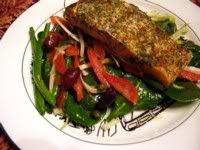
1/4 cup red wine vinegar
1/4 cup shallots, finely diced
3/4 cup extra virgin olive oil
Salt to taste and freshly ground pepper
3/4 cup snipped nasturtium flowers
1/4 cup snipped fresh chives
8 (3 ounces each) pieces of salmon fillet
Chives for garnish
Preheat broiler or grill. Combine vinegar, shallots, and all but 2 tablespoons olive oil. Whisk until combined. Salt and pepper to taste. Add nasturtiums and chives. Rub salmon with remaining olive oil. Season with salt and pepper. Place on grill for 3 minutes. Turn, and cook until done (about 3 more minutes, depending on thickness). Place two pieces of salmon on each serving plate. Whisk vinaigrette and spoon over salmon. Garnish with fresh chives. Yield: 4 servings
Nasturtium Pesto
Into a food processor or blender, put the following ingredients:
4 cups packed nasturtium leaves
3 to 5 cloves of garlic
1 and 1/2 cups olive oil
2 drops Tabasco sauce
1 cup walnuts
Process the mixture until smooth. To store the pesto, you can freeze it in ice cube trays so it's ready whenever you need it. The pesto is excellent on top of grilled salmon, halibut, chicken or steak.

No comments:
Post a Comment